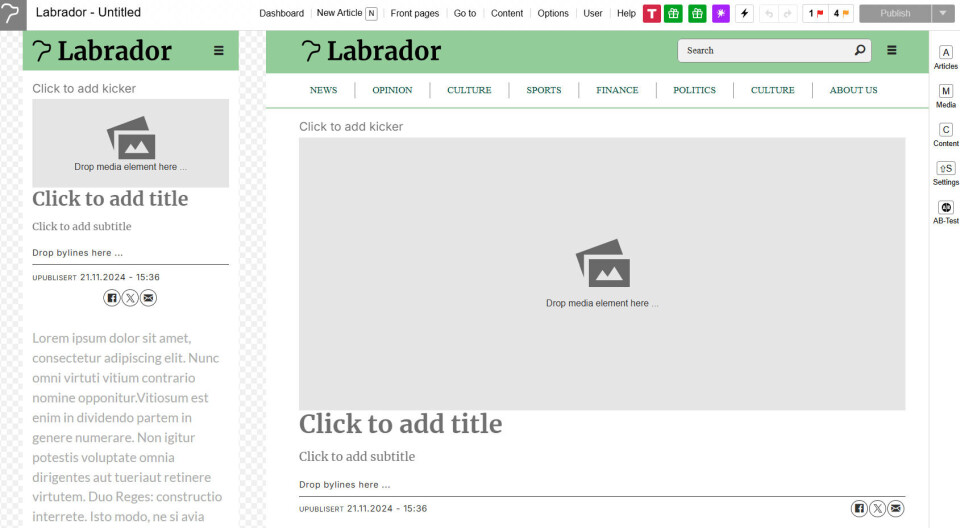
11 Reasons You Need a Magazine CMS for Your News Website
Standard content management systems can be just good enough, but a specialized magazine CMS is a better choice for a news website. Here’s why.
If you wanted to make a drawing of a house, a simple tool such as Paint or just a sheet of paper could do the job. However, you’d use specialized tools such as AutoCAD to create an architectural blueprint for a job well done. So why do many news websites still use platforms that are not fit for the job?
Using a dedicated CMS built for magazine publishers is like using a high-precision tool for any job. It will be done faster and more efficiently, and the end-user will be happier. Today, we look at some of the most important reasons to consider your old content management system and replace it with a modern, sleek magazine CMS.
What is a magazine CMS anyway?
A magazine CMS is a specialized content management system that helps publishers create, manage, and distribute digital magazine content.
Unlike general-purpose CMS platforms, it has custom features that address the needs of digital publications, such as editorial workflows, stunning visual layouts, audience engagement features, detailed analytics, and much more.
But why should you care?
Why would you need a dedicated magazine CMS?
You may be already using a standard CMS such as WordPress or Webflow. And while these are excellent content management systems, they’re not specialized tools for the job. Below, we listed some of the most common reasons why you’ll need a magazine CMS instead of a more general one used on other types of websites.
Instead of the technical aspects of running a website, you can focus on great journalism.
1 Tailored content management
The average business publishes content differently compared to a magazine. There’s typically a blog, and a few people publish content without a specific schedule. On the other hand, a magazine website is a well-oiled machine with many moving parts.
You’ll need the following:
Content categorization: sections, authors, categories, tags, archives and more. Each post should have its dedicated place in a system, allowing you and your readers to find it easily.
Editorial workflows: processes for content planning, editing, approval and scheduling for multiple authors and editors.
Issue-based publishing: the ability to organize content into editions or issues.
2 Advanced layout flexibility
The average CMS only allows a few changes apart from the usual content setup. While you can change the multimedia and content shown in a news piece, you can’t change much more than that.
A dedicated magazine CMS such as Labrador allows you to change how a post looks on different devices. Want more images on mobile? A larger heading on the desktop? You got it. You can even edit the mobile and web versions of the same piece of content simultaneously.
You can change everything from how images are shown to the size of the heading, the placement of the images within the text, and much more.

3 Excellent performance with high-volume content
The average website has five to thirty pages. We’re talking about the typical small-to-midsize business with the regular home, About, Careers, and other pages. Conversely, a magazine CMS may have multiple articles going out every day or even hour.
The CMS should be able to handle a large volume of pages with ease. This means:
No issues with page load speed and performance
- No lag with content management in the back end
- Scalability to support spikes in traffic when new content goes live
An easy way to tag and categorize large volumes of content based on author, topic and more
In short, the website should perform just as well as your local bakery’s presentation with a few pages.
4 Monetization features
Magazine websites have different methods for making revenue outside of ads. The right magazine CMS platform will have integrations for different subscription models, paywalls, and freemium content. This lets you determine which content is free and what should be locked behind a paywall.
5 An improved user experience
Today's website visitors have countless platforms that beg for their attention, which means that once they’re on your news website, their experience should be perfect.
This means:
A fully optimized mobile layout
Infinite scrolling
Dynamic carousels
Pages that load with lightning speed
And much more. If you don’t know what to start with, aim for mobile optimization as your first and main criterion. The reason is simple: 82% of your readers use mobile to access a news website.
6 Collaboration and workflow tools
Not everyone on your team will create and publish content. Traditional CMS platforms don’t recognize a wide variety of roles except for content creators, moderators, and administrators.
On the other hand, a magazine CMS will be far more nuanced. It will include roles such as:
Journalist
Editor
Designer
And many others. This allows your team to create content in the cloud, contribute to it, approve it, send it off to publishing, and track its performance. Speaking of which…
7 Analytics for publications
Pair any CMS with a free tool such as Google Analytics, and you’ll get a wealth of information about your magazine's website. But this barely scratches the surface.
With a dedicated magazine CMS, you’ll unearth insights such as:
Engagement per category, tag, and author
Information about subscription trends and performance
Details on which posts are driving visits and which ones get new subscriptions
A leaderboard with your top authors, categories, topics and more
8 SEO and social sharing optimization
Most content management systems nowadays have some SEO features. The ability to create and edit meta descriptions, image alt tags, SEO titles and more are provided by default. However, a news magazine CMS needs to have a few extra tricks up its sleeve.
For example, you’ll need a schema for long-form content, as well as optimizations for author bios.
9 Multimedia support
A piece of news is rarely just text. You want to include relevant images, audio files, video clips, and much more for a full-blown article. The average CMS can give you that, but only with extra tinkering. You’ll need add-ons, custom code and quite a bit of setup to get what you need.
A magazine CMS such as Labrador has these features out of the box. For example, Labrador CMS allows you to embed each of these formats easily, either from your own devices or through integration with online image libraries.
10 Reader retention tools
The best news websites keep readers returning for more. While quality content is the number one tool for this job, the CMS can also provide a range of features to retain readers on the website.
For example, push notifications, newsletters and personalized news recommendations for readers to keep them clicking through and reading more.
11 Cost efficiency in the long run
Sure, WordPress is free, and Wix may be very affordable. Newer headless CMS tools are also fairly cheap. But think of what you get from the box. To make a standard CMS suitable for a magazine use case, you’re going to have to spend:
Plenty of money on third-party plugins
Even more money on developers to set things up
Lots of time to make everything work as it should
It may seem like you’re getting a great deal but in reality, you’ll spend more time and money to make a basic CMS into one suitable for magazines.
Conclusion
On the surface, any CMS can be used for a news website. And that is true. However, the results from that website will differ significantly from one built on a custom, dedicated magazine CMS.
With Labrador CMS, you get all of the features you need to build an amazing online presence for your magazine. All that is left for you to do is create amazing content.
But don’t just take our word for it. Book a free demo with our team to find out how we can help!

